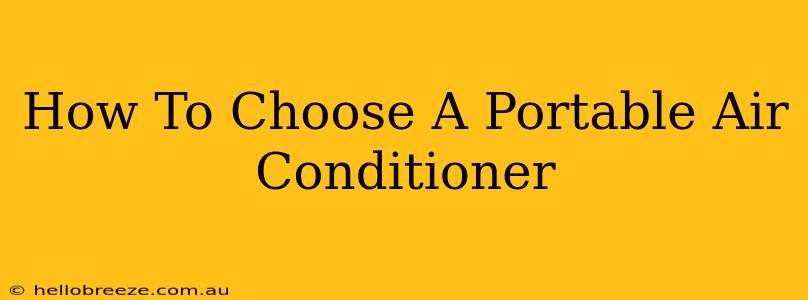Summer heat got you sweating? A portable air conditioner could be your salvation. But with so many options on the market, choosing the right one can feel overwhelming. This comprehensive guide will walk you through the key factors to consider when selecting a portable AC unit to beat the heat in style and comfort.
Understanding Your Cooling Needs: Size Matters!
Before diving into features, determine the size of the space you need to cool. This is crucial for effective cooling and energy efficiency. A unit too small will struggle to lower the temperature, while one too large will be unnecessarily expensive to run and might even cycle on and off too frequently.
BTU Rating: The Key to Sizing
The British Thermal Unit (BTU) rating indicates the cooling capacity of the air conditioner. This is the most important factor to consider. Here's a general guideline:
- Small Room (under 250 sq ft): 5,000-7,000 BTU
- Medium Room (250-400 sq ft): 7,000-10,000 BTU
- Large Room (400-600 sq ft): 10,000-14,000 BTU
Important Note: These are estimates. Factors like insulation, window size, number of occupants, and the amount of sunlight entering the room will influence your BTU needs. Consult online BTU calculators for more precise estimations based on your specific circumstances.
Key Features to Consider: More Than Just Cooling
While BTU rating is paramount, several other features significantly impact your comfort and experience:
1. Energy Efficiency: Saving Money and the Planet
Look for a unit with a high Energy Efficiency Ratio (EER) or Energy Star rating. A higher rating means the unit uses less energy to produce the same amount of cooling, saving you money on your electricity bill and reducing your environmental impact.
2. Noise Level: Peace and Quiet, Please!
Portable AC units can be noisy. Check the decibel (dB) rating. Lower dB means quieter operation, essential for bedrooms or areas where noise is a concern. Look for models with features like noise reduction technology.
3. Exhaust Hose: Efficient Heat Removal
The exhaust hose vents hot air outside. Ensure the hose is long enough to reach a window or other suitable venting point. Some models offer flexible hoses for easier placement. Consider units with double-hose systems for superior cooling efficiency.
4. Dehumidification: Combating Dampness
Many portable air conditioners offer dehumidification capabilities, which can be beneficial in humid climates. This feature removes excess moisture from the air, improving comfort and preventing mold growth.
5. Additional Features: Enhancing Comfort and Convenience
Consider these optional features:
- Remote control: For convenient operation from anywhere in the room.
- Timer: Set the unit to turn on or off automatically.
- Multiple fan speeds: Customize airflow to your preference.
- Sleep mode: Gradually reduces cooling power for energy savings during sleep.
- Filters: Essential for maintaining air quality and extending the unit’s lifespan.
Installation and Maintenance: Easy Setup and Long Lifespan
Portable air conditioners are designed for easy setup. However, you'll need a window kit or other venting solution to exhaust hot air outside. Regular maintenance, such as cleaning filters and coils, is crucial for optimal performance and a longer lifespan.
Choosing the Right Portable Air Conditioner: Final Thoughts
Selecting a portable air conditioner involves careful consideration of several factors. By understanding your cooling needs, reviewing key features, and considering your budget, you can choose a unit that provides efficient, reliable, and comfortable cooling throughout the summer. Remember to prioritize BTU rating, energy efficiency, and noise level to ensure a worthwhile investment.

